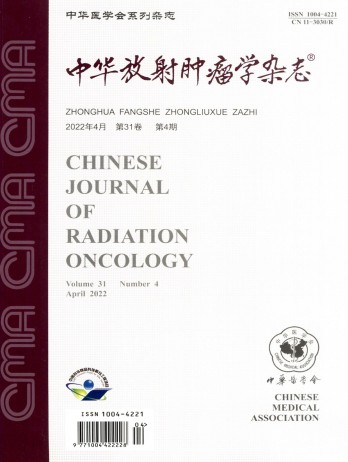基于深度学习的自动分割模型在乳腺癌放疗中的临床应用及评价
引用次数: 0
摘要
目的将深度学习算法与商业规划系统相结合,建立并验证乳腺癌患者临床靶体积(CTV)和危重器官(OARs)的自动分割平台。方法选取400例在肿瘤医院CAMS行保乳手术后接受放疗的左右乳腺癌患者为研究对象。采用深度残差卷积神经网络对CTV和OARs分割模型进行训练。建立了端到端的深度学习自动分割平台。使用42例左乳腺癌和40例右乳腺癌患者验证了DLAS平台划定的准确性。计算总体骰子相似系数(DSC)和平均豪斯多夫距离(AHD)。逐层计算分析各层相对位置与各层DSC值(DSC_s)之间的关系。结果左/右乳腺癌患者整体CTV的平均总DSC和AHD分别为0.87/0.88和9.38/8.71 mm。左/右乳腺癌患者所有桨叶的平均总DSC和AHD范围分别为0.86 ~ 0.97和0.89 ~ 9.38 mm。CTV和OARs的逐层分析均达到0.90及以上,表明医生只需要进行轻微修改或不需要修改,CTV自动划定的DSC_s≥0.9的层数约占44.7%。OARs的自动圈定范围为50.9% ~ 89.6%。当DSC_s< 0.7时,CTV和非脊髓感兴趣区域的DSC_s值在两侧边界区域(层位0 ~ 0.2和0.8 ~ 1.0)显著降低,且向边缘降低的程度更为明显。脊髓以全面的方式勾画,在特定区域未观察到明显的DSC_s减少。结论基于深度学习的端到端自动分割平台可以整合乳腺癌分割模型,取得良好的自动分割效果。上下方向两侧边界区域圈定一致性下降较为明显,有待进一步提高。关键词:自动分割;深度学习;乳房肿瘤/放射疗法本文章由计算机程序翻译,如有差异,请以英文原文为准。
Clinical application and evaluation of automatic segmentation model based on deep learning for breast cancer radiotherapy
Objective
In this study, the deep learning algorithm and the commercial planning system were integrated to establish and validate an automatic segmentation platform for clinical target volume (CTV) and organs at risk (OARs) in breast cancer patients.
Methods
A total of 400 patients with left and right breast cancer receiving radiotherapy after breast-conserving surgery in Cancer Hospital CAMS were enrolled in this study. A deep residual convolutional neural network was used to train CTV and OARs segmentation models. An end-to-end deep learning-based automatic segmentation platform (DLAS) was established. The accuracy of the DLAS platform delineation was verified using 42 left breast cancer and 40 right breast cancer patients. The overall Dice Similarity Coefficient (DSC) and the average Hausdorff Distance (AHD) were calculated. The relationship between the relative layer position and the DSC value of each layer (DSC_s) was calculated and analyzed layer-by-layer.
Results
The mean overall DSC and AHD of global CTV in left/right breast cancer patients were 0.87/0.88 and 9.38/8.71 mm. The average overall DSC and AHD range for all OARs in left/right breast cancer patients were ranged from 0.86 to 0.97 and 0.89 to 9.38 mm. The layer-by-layer analysis of CTV and OARs reached 0.90 or above, indicating that the doctors were only required to make slight or no modification, and the DSC_s ≥ 0.9 of CTV automatic delineation accounted for approximately 44.7% of the layers. The automatic delineation range for OARs was 50.9%-89.6%. For DSC_s< 0.7, the DSC_s values of CTV and the regions of interest other than the spinal cord were significantly decreased in the boundary regions on both sides (layer positions 0-0.2, and 0.8-1.0), and the level of decrease toward the edge was more pronounced. The spinal cord was delineated in a full-scale manner, and no significant decrease in DSC_s was observed in a particular area.
Conclusions
The end-to-end automatic segmentation platform based on deep learning can integrate the breast cancer segmentation model and achieve excellent automatic segmentation effect. In the boundary areas on both sides of the superior and inferior directions, the consistency of the delineation decreases more obviously, which needs to be further improved.
Key words:
Automatic segmentation; Deep learning; Breast neoplasm/radiotherapy
求助全文
通过发布文献求助,成功后即可免费获取论文全文。
去求助
来源期刊
自引率
0.00%
发文量
6375
期刊介绍:
The Chinese Journal of Radiation Oncology is a national academic journal sponsored by the Chinese Medical Association. It was founded in 1992 and the title was written by Chen Minzhang, the former Minister of Health. Its predecessor was the Chinese Journal of Radiation Oncology, which was founded in 1987. The journal is an authoritative journal in the field of radiation oncology in my country. It focuses on clinical tumor radiotherapy, tumor radiation physics, tumor radiation biology, and thermal therapy. Its main readers are middle and senior clinical doctors and scientific researchers. It is now a monthly journal with a large 16-page format and 80 pages of text. For many years, it has adhered to the principle of combining theory with practice and combining improvement with popularization. It now has columns such as monographs, head and neck tumors (monographs), chest tumors (monographs), abdominal tumors (monographs), physics, technology, biology (monographs), reviews, and investigations and research.

 求助内容:
求助内容: 应助结果提醒方式:
应助结果提醒方式:


